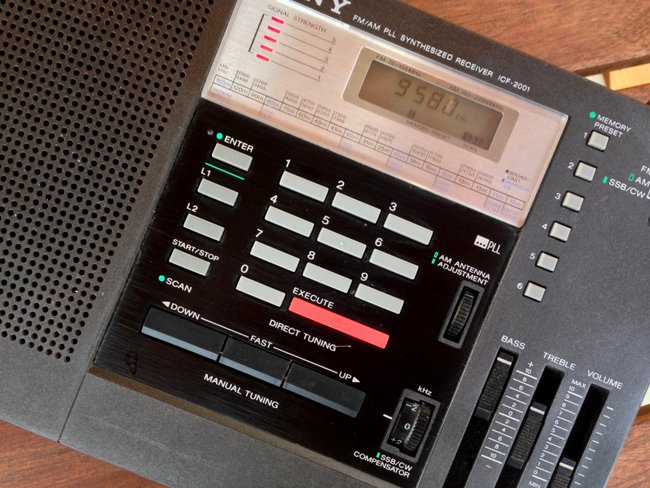I’ve mentioned many times before what a joy it is to curate the Shortwave Radio Audio Archive (SRAA). Sometimes I’m sent recordings that evoke a flood of memories. SRAA contributor, Tom Laskowski, just submitted another such recording.
Tom included the following notes with his Radio RSA – Voice of South Africa recording:
Every Saturday night during the early 1980s [in South Bend, Indiana] I would regularly tune to 9580 kHz at 0200 to listen to Radio RSA (Channel Africa as it is now known) to hear DX Corner, their regular DX program.
This episode from March 14, 1982 was a look at a brand new hot radio, the Sony ICF-2001.
The audio isn’t great but should be listenable. I think this was recorded using my new Realistic DX-302. Enjoy:
Click here to download this recording as an MP3.
Thank you, Tom! I think Radio RSA did an admirable job reviewing the ICF-2001!
Post Readers: You can listen to more archived shortwave recordings at the SRAA website, or by subscribing to the audio feed via iTunes. You can also listen to the archive on TuneIn radio.


As an owner of ICF-2001 I always tell that it is one of the most underestimated Sony radios. In terms of sensitivity sometimes it beats even ICF-2001D/2010 which I also have, so I had a chance to make my own comparison. It only lacks a narrow filter on board which 2001D has but other than that it is still a great radio!
Wasn’t the RSA interval signal a chirping/singing back then? Yeah, I know, I could do a search.
I listened to RSA fairly often during the 1970’s. This could be armchair copy in California. The Meyerton shortwave station is not as easy to receive on the US West Coast as it was then. I did listen to Sonder Grense and BBC World Service from Meyerton last week.
Thanks for sharing the recording. This was fun to listen to.
Outside of Arnie Corro’s DXers Unlimited what other shows focusing on Shortwave listening are available on shortwave now days?
As for the ICF-200 I will never understand why Sony has been so big on their direct frequency entry model. They have made several receivers without a tuning knob. I just can’t get into using direct entry or frequency up and down buttons without a way to casually scroll through the bands.
Thanks again!
Marty
W5MRM
Maybe Sony perceives their main audience as listener, ie people who will tune to specific frequencies for a specific show or station. They kept selling SW receiver because they could sell to a wider group than those who identify as “hobbyist”.
When the Sony 2000 came out, it was a new thing, synthesized tuning was a new thing for consumer electronics, so how to tune them was up in the air. I think there was one ham rig, maybe an Astro, that had tuning knob, but it was more like an up down button, turn one way for up, the other way for down. I think, but not certain, that how far you turned the knob determined how fast the frequency changed (something akin to up/down buttons that stepped at a slow rate initially, but faster if you held the button down longer.
I’m not sure when quadrature tuning knobs became commercially available. I remember various projects that included home made versions, so either the commercial ones were expensive or arrived later. That might impact on things.
Or maybe it was oversight, not imagining a demand.
Michael
As a normal component (i.e. not custom-made or industrial versions), incremental/quadrature encoders started appearing in commercial/semi-pro gear about that same time – but yes, they were a bit on the expensive side, & being mechanical they weren’t very reliable (optical ones were much more expensive). Membrane switches had really only become practical a couple of years before but, despite being even more unreliable, were a lot cheaper.
Hard to say if it was cause or effect but the general aesthetic of the time shifted to one where rotary controls were considered ‘old fashioned’, so everything that could become push-button did. I guess we can be thankful that tuning controls didn’t follow the other trend of the time and become sliders…
Re: the ?Astro? ham rig you mentioned: I helped design an add-on for a Yaesu which replaced the analogue VFO with a DDS. During prototyping I rigged up the fine tune as you described – dead spot in the centre, but the further you turned the faster it tuned up/down. After about 5 minutes testing I re-wrote the code to make it absolute tuning 😉